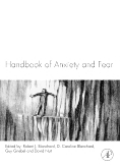
Handbook of anxiety and fear
Blanchard, Robert J.
Blanchard, D. Caroline
Griebel, Guy
This Handbook brings together and integrates comprehensively the core approaches to fear and anxiety. Its four sections: Animal models; neural systems; pharmacology; and clinical approaches, provide a range of perspectives that interact to produce new light on these important and sometimes dysfunctional emotions. Fear and anxiety are analyzed as patterns that have evolved on the basis of their adaptive functioning in response to threat. These patterns are stringently selected, providing a close fit with environmental situations and events;they are highly conservative across mammalian species, producing important similarities, along with some systematic differences, in their human expression in comparison to that of nonhuman mammals. These patterns are described, with attention to both adaptive and maladaptive components, and related to new understanding of neuroanatomic, neurotransmitter, and genetic mechanisms.Although chapters in the volume acknowledge important differences in views of fear and anxiety stemming from animal vs. human research, the emphasis of the volume ison a search for an integrated view that will facilitate the use of animal models of anxiety to predict drug response in people; on new technologies that will enable direct evaluation of biological mechanisms in anxiety disorders; andon strengthening the analysis of anxiety disorders as biological phenomena. This book integrates animal and human research on fear and anxiety. It presentsemerging and developing fields of human anxiety research including imaging ofanxiety disorders, the genetics of anxiety, the pharmacology of anxiolysis, recent developments in classification of anxiety disorders, linking these to animal work. It covers basic research on innate and conditioned responses to threat. It presents work from the major laboratories, on fear learning and extinction. It reviews research on an array of neurotransmitter and neuromodulator systems related to fear and anxiety. It compares models, and neural systems forlearned versus unlearned responses to threat. It relates the findings to the study, diagnostics, and treatment of anxiety disorders, the major source of mental illness in modern society (26 per cent of Americans are affected by anxiety disorders!)
- ISBN: 978-0-444-53065-3
- Editorial: Elsevier Science
- Encuadernacion: Cartoné
- Páginas: 450
- Fecha Publicación: 01/03/2008
- Nº Volúmenes: 1
- Idioma: Inglés
